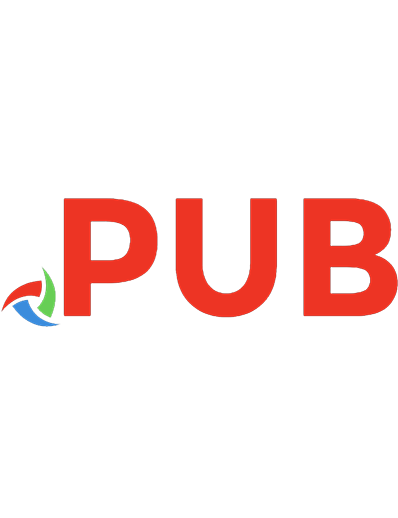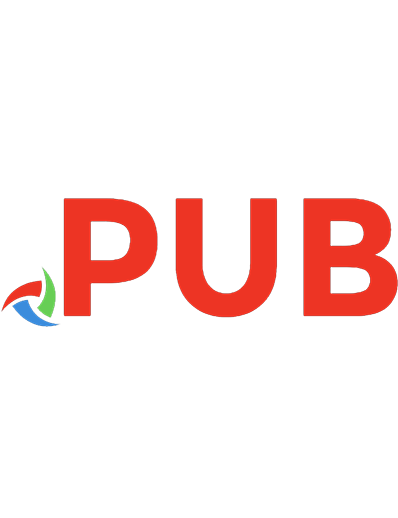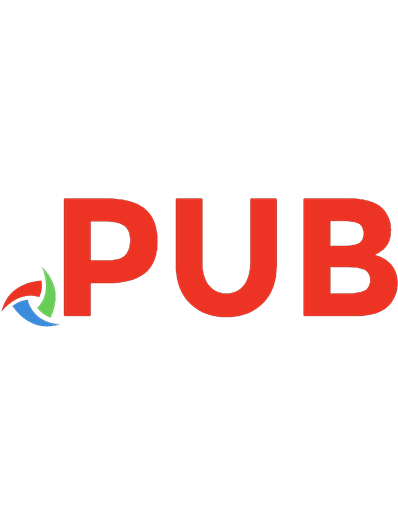Fundamentals of IoT 9789355518644
A comprehensive guide to IoT's core concepts and principles KEY FEATURES ● Discover the fascinating world of Arduin
157 101 11MB
English Pages 323 Year 2023
Table of contents :
Cover
Title Page
Copyright Page
Dedication Page
About the Authors
About the Reviewer
Acknowledgement
Preface
Table of Contents
1. Introduction to Internet of Things
Introduction
Structure
Objectives
Internet of Things
Internet oriented vision
Things oriented vision
Semantic oriented vision
Conceptual framework
Architectural view of IoT
Sensing layer
Gateways and network layer
Management service layer
Application layer
Technologies behind IoT
ZigBee
Thread
Z-wave
Wi-Fi
RFID
NFC
LTE-Cat M1
Bluetooth
NB-IoT
LoRaWan
Sigfox
Sources of IoT
Data from passive source
Data from active source
Data from dynamic source
Conclusion
Key terms
Questions
2. Hardware for IoT
Introduction
Structure
Objectives
Sensors
Types of sensors
Accelerometer sensor
Chemical sensor
Humidity sensor
Level sensor
Motion senor
Optical sensor
Pressure sensor
Proximity sensor
Temperature sensor
Touch sensor
Digital sensors
Digital accelerometers
Digital temperature sensor
Characteristics of sensors
Static characteristics
Dynamic characteristics
Actuators
Types of actuators
Hydraulics actuators
Pneumatic actuators
Electrical actuators
Thermal/magnetic actuators
Mechanical actuators
Relay actuators
Radio frequency identification technology
Types of RFID
Working principle of RFID
Applications of RFID
Advantages of RFID
Disadvantages of RFID
Wireless sensor networks
Types of wireless sensor network
Classification of wireless sensor networks
Structure of wireless sensor network
Applications of WSN
Characteristics of WSN
Participatory sensing technology
Conclusion
Key terms
Questions
3. Embedded Platforms for IoT
Introduction
Structure
Objectives
Embedded system in IoT
Challenges of IoT embedded software
Embedded computing examples
Central heating systems
GPS
Medical devices
Automotive system
Factory robot
Interactive kiosks
IoT-supported hardware platforms
Arduino
Netduino
Raspberry Pi
Beagle Bone
Intel Galileo
Arms cortex
Conclusion
Key terms
Questions
4. Programming the Arduino
Introduction
Structure
Objectives
Overview of Arduino
Arduino UNO
Arduino Nano
Arduino Mega
Arduino Micro
Arduino Leonardo
Arduino Due
Arduino Shields
Arduino Lilypad
Arduino Bluetooth
Arduino Diecimila
Arduino Robot
Arduino Ethernet
Arduino Zero
Arduino Esplora
Anatomy of Arduino UNO
Arduino IDE (a programming environment)
Toolbar
Menu bar
Programming the Arduino
Programming the Arduino for IoT
Coding Arduino using emulator
Arduino libraries
Types of Arduino libraries
Standard libraries
Library manager libraries
User installed libraries
Conclusion
Key terms
Questions
5. IoT and M2M Design Standards
Introduction
Structure
Objectives
M2M communication
Applications of M2M communication
Types of M2M communication
Wired communication
Wireless communication
RFID
NFC
Wi-Fi
Cellular network
ZigBee
Bluetooth
Working of M2M communication
Design principles for the connected device
Focus on value
Take a holistic view
Put safety first
Consider the context
Build a strong brand
Prototype early and often
Use data responsibly
IoT/M2M system layers
IoT/M2M design standardization
International telecommunication union
Institute of electrical and electronics engineers
3GPP
Internet engineering task force
Organization for the advancement of structured information standard
International organization for standardization
Open mobile alliance
Communication technologies in IoT
Bluetooth
Zigbee
Z-wave
Wi-Fi
Cellular
NFC
LoRaWAN
Data enrichment
Method for data enrichment
Benefits of data enrichment
Data consolidation
Importance of data consolidation
Data consolidation techniques
Data consolidation challenges
Ease of designing and affordability of IoT systems
Conclusion
Key terms
Questions
6. Network and Communication Aspects of IoT
Introduction
Structure
Objectives
Architecture of IoT
Centralized IoT Architecture
Fog Computing IoT Architecture
Edge Computing IoT architecture
Hybrid IoT Architecture
Network and communication aspects
Protocols used in IoT
Physical layer protocols
Data link layer protocols
Network layer protocols
Transport layer protocols
Message Queuing Telemetry Transport
Constrained Application Protocol
Hypertext Transfer Protocol
Application layer protocols
Wireless medium access issues
MAC protocol survey
Requirement of MAC protocol
Sensor deployment
Classification of sensor deployment
Random deployment
Deterministic deployment
Node discovery
Methods of node discovery
Process of node discovery
Data aggregation
Importance of data aggregation
Data dissemination
Importance of data dissemination
Conclusion
Key terms
Questions
7. IoT Design Challenges
Introduction
Structure
Objectives
IoT design challenges
Interoperability
Security
Power consumption
Scalability
Data processing
User experience
Development challenges of IoT
Security
Connectivity
Cross-platform compatibility
Data collection
Costs
Reliability and hardware
Ease of integration
Development skillset
Quality control
Design
Security challenges of IoT
Incorrect access control
Overly large attack surface
Outdated software
Lack of encryption
Data Interception
Data tampering
Application vulnerabilities
Lack of trusted execution environment
Vendor security posture
Insufficient privacy protection
Intrusion ignorance
Insufficient physical security
User interaction
Other challenges
Smart sensors
Device management
Lack of regulation
Interoperability
End-user challenges
Conclusion
Key terms
Questions
8. Applications of IoT
Introduction
Structure
Objectives
Applications of IoT
Smart metering
Architecture of Smart metering system
Components of smart metering system
Smart Health
Healthcare monitoring using IoT
Remote patient monitoring
Glucose monitoring
Heart-rate monitoring
Hygiene monitoring
Depression and mood monitoring
Parkinson’s disease monitoring
Smart inhalers
Ingestible sensors
Smart pill bottles
Connected contact lenses
Robotic surgery
Moodables
Healthcare charting
Smart video pills
Hearables
Framework of smart health
City automation
Traffic management
Air pollution
Healthcare
Public transport
Water management
Buildings
Waste management
Parking
Natural disaster management
Infrastructure
Automotive applications
Fleet and driver management
Driver assistance and safety
Real time vehicle telematics
Cellular vehicle to everything
IoT based predictive maintenance
In-vehicle infotainment and comfort
Home automation
Applications of home automation
Lighting
Bathrooms
Gardens
Kitchen
Security system
Heating, ventilation, and air conditioning
Doors and windows
Home routine
Smart cards
Working of smart cards
Types of smart cards
Contact-based smart cards
Contactless cards
Hybrid smart cards
Memory smart cards
Microprocessor smart cards
Advantages of smart cards
Security
Information persistence
Disadvantages of Smart cards
Communicating data with H/W units in IoT systems
Designing smart street lights in smart city
IoT in mobile devices
Conclusion
Key terms
Questions
Appendix: Hands-On Practical Problems
Introduction
Program 1- Code the Arduino for sensing temperature and humidity
Hardware required
Program 2- Code the Arduino for connecting ultrasonic sensor
Hardware required
Program 3- Code Arduino for connecting MQ2 gas sensor for detecting gases
Hardware required
Program 4- Code Arduino for connecting Bluetooth module
Hardware required
Program 5- Code Arduino for using a Wi-Fi module
Hardware required
Program 6- Code Arduino for monitoring sensor data over the internet
Hardware required
Program 7- Code Arduino for using a Wi-Fi module
Hardware required
Program 8- Code Arduino for creating a local server
Hardware required
Program 9- Code Arduino for controlling a light/fan at home
Hardware required
Program 10- Code Arduino to control devices connected to an Arduino from the address bar of a web browser
Hardware required
Program 11- code Arduino for reading and updating sensor data over cloud
Index



![Iot Fundamentals: Networking Technologies, Protocols, And Use Cases For The Internet Of Things [1 ed.]
9386873745, 9789386873743](https://dokumen.pub/img/200x200/iot-fundamentals-networking-technologies-protocols-and-use-cases-for-the-internet-of-things-1nbsped-9386873745-9789386873743.jpg)






